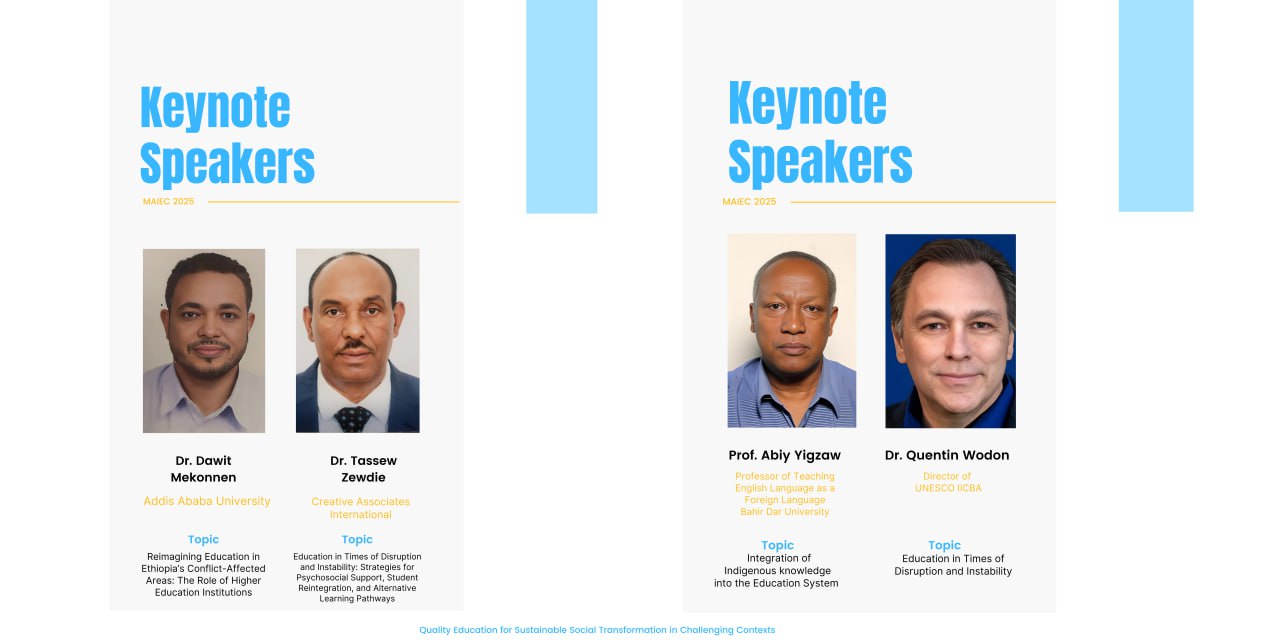
Reimagining Education in Ethiopia’s Conflict-Affected Areas: The Role of Higher Education Institutions
Dr. Dawit Mekonnen
Ethiopia has faced an unprecedented education crisis, with close to 10 million children currently out of school. The majority of these children are in the Amhara region. The challenges extend beyond traditional barriers such as poverty and access; conflicts in various parts of the country have emerged as critical factors. Schools have been destroyed, instructional time has been wasted, and both teachers and learners are suffering from trauma. In some communities, the demand for education has sharply declined due to ongoing insecurity and dwindling employment prospects, leaving large numbers of students out of school for years. Although the roots of exclusion from education are deeply embedded in socio-economic conditions, the conflict/war has significantly exacerbated the situation. These shocks have struck before the system could fully recover from the devastating effects of the COVID-19 pandemic and the Northern Ethiopia war. The education sector’s response in these circumstances cannot rely on conventional mechanisms. Emergency and conflict contexts demand distinct strategies—ones that are flexible, innovative, community-oriented, and resilient. This keynote addresses the need for a comprehensive and context-sensitive approach to potential education response and recovery in war-affected areas. It explores critical interventions at multiple levels: systemic reform and planning, curriculum adaptation, flexibility, and pedagogy, teacher deployment and support, student welfare, and parental engagement. It also explores an operational research agenda to guide evidence-informed responses in crisis-affected areas. It is necessary to reimagine education service delivery in a way that responds to consecutive years of disaster, conflict, and trauma, so that education becomes a force for healing, stability, personal and social development, and recovery. This cannot be achieved through the traditional business-as-usual model; universities should lead the way in response and recovery.
Integration of indigenous knowledge in Ethiopia
Prof. Abiy Yigzaw
Indigenous knowledge preserves cultural heritage, enhances educational relevance, and fosters a sense of community ownership. It encompasses a wide range of traditional practices, beliefs, and understandings passed down from generation to generation. It's a dynamic, adaptive, and holistic system of knowledge that reflects a deep connection to the natural world, cultural traditions, and social structures. This knowledge is found in various forms, including technical, environmental, agricultural, sociocultural, and historical knowledge. The following are examples of indigenous knowledge: traditional ecological knowledge, which is understanding local ecosystems, weather patterns, and seasonal changes to predict natural events and manage resources sustainably; and agricultural practices, which are social classification, seed storage, and planting methods developed over centuries to optimize crop yields and food security. The others are fire management and medical plant use, which are strategies vital for the ecosystem health and knowledge of plants with healing properties to maintain overall health. The other ones are traditional hunting and fishing techniques which sustainably harvest wildlife and aquatic resources, craftsmanship and indigenous technology, which are applied in crafting tools, and cultural heritage and practices, which are preservatives of knowledge, values and social cultures. Still others are biodiversity conservation, environmental management, and indigenous governance and social structure, which are habitat preservation and maintenance of traditional ecosystems, strategies for managing resources, preventing pollution, and mitigating the impacts of natural disasters, and traditional systems of decision-making, conflict resolution, and social organization that ensure the well-being of the community and respect for the environment.
Indigenous knowledge may be herbal medicines composed of herbs that contain active ingredients, parts of plants, or other plant materials, or combinations thereof. Traditional medicines may also use animal parts and/or minerals (WHO, 2002–2005). It is estimated that at least 25% of all modern medicines are derived, either directly or indirectly, from medicinal plants, primarily through the application of modern technology to traditional knowledge. Other types of indigenous knowledge are many and serve people.
An example of indigenous knowledge is that children do not shelter under a big tree when lightning is expected; this is because they believe that tall trees attract lightning. In rural parts of the country, if someone is hit by lightning, they immediately contact with moist ground or dung, which is considered a cure. Though the rural people are not able to explain the why of the stated safety precaution and treatment, this can be substantiated by static electricity theory. This may help to teach Ethiopian students about lightning or static electricity discharge.
